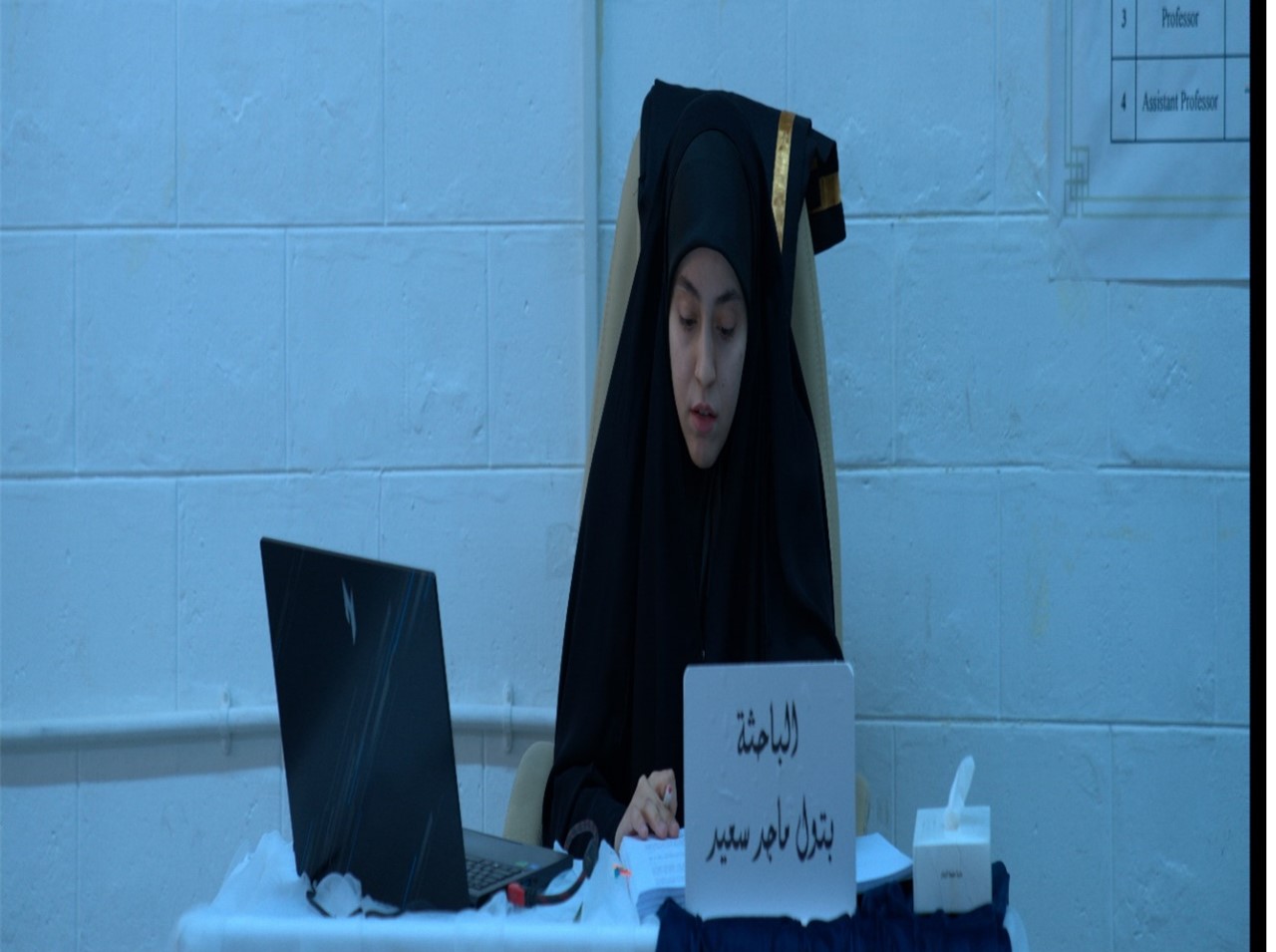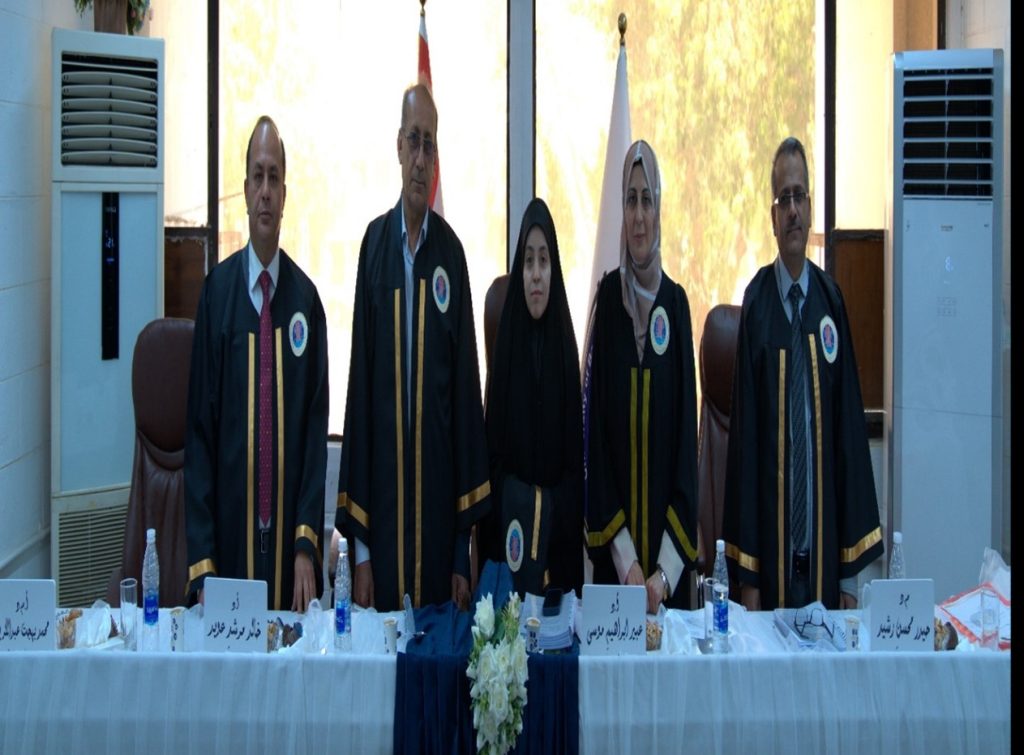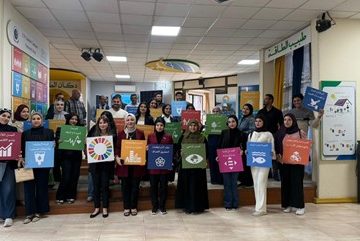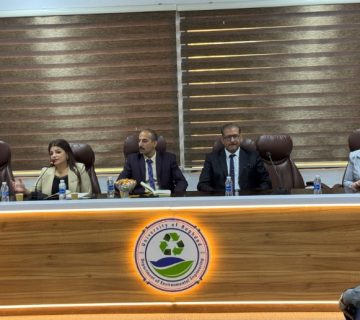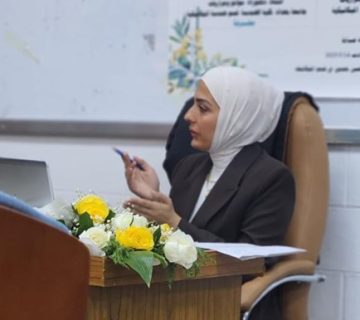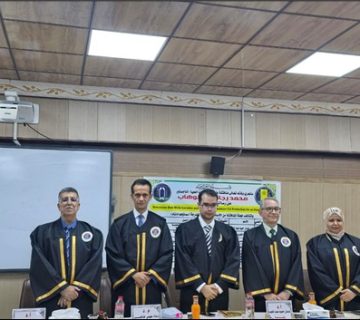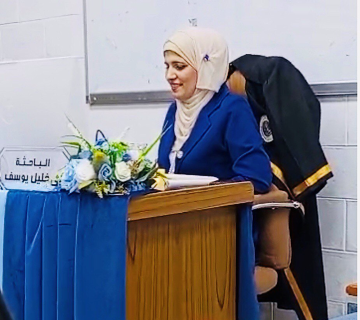The College of Engineering at the University of Baghdad held the public defense of M.Sc. student Batool Majid Saeed for his dissertation titled:
“Modification of the Iraqi Red Kaolin Clay Using Cetyltrimethyl Ammonium Bromide for the Removal of Methylene Blue in Wastewater”
This event took place on Monday, May 12, 2025, in the discussion hall of the Department of Environmental Engineering, under the supervision of Asst. Prof. Dr. Mohammed Bahjat. The examination committee consisted of Prof. Dr. Abeer Ibrahim, Prof. Dr. Khaled Morshed Owaid and Lec.Dr. Haider Mohsen Rasheed.
Wastewater dyes are one of the most important problems facing the ecosystem, especially those left behind from paper, textile and leather production processes. One of these organic dyes is methylene blue (MB). Natural adsorbents including clays are readily available, low-cost, and eco-friendly easily regeneration methods materials, to enhance the removal efficiency of the adsorbents several modification methods used in previous studies. In this research, adsorption technique was used to remove synthetic methylene blue dye from water using kaolin clay as an adsorbent, batch and continuous system was used in this study.
The adsorption capacity of Iraqi red kaolin (IRK) was improved by modifying it with cetyltrimethylammoniumbromide (CTAB) to become hydrophobic clay (organioclay) CTAB-IRK(. The characterization of natural and modified kaolin were carried out using several analyses such as Fourier-transform-infrared-spectroscopy (FTIR), X-ray-fluorescence analysis (XRF), X-ray-diffraction (XRD), Energy-Dispersive X-ray spectroscopy (EDS), Scanning-Electron-Microscopy (SEM), and Brunauer-Emmett-Teller analysis (BET). On the other hand, the adsorption efficiency of methylene blue dye by kaolin before and after the modification process were studied, and the effect of many parameters on this adsorption process was determined such as adsorbent doses (0.05-0.1 g/100 mL), equilibrium time (0-180 min), initial pH (2-10), agitation speed (0-350 rpm), and adsorbate initial concentration (50-600 mg/L), the best of them that achieves the best conditions suitable for adsorption was adopted. It was showed that modified kaolin was successful and increased the adsorption efficiency of methylene blue dye from (73%) to (98%) with dose ratio (0.5 g CTAB/g natural kaolin).
From this study, it can be concluded that natural kaolin is a good adsorbent for removing methylene blue. However, the adsorption process can be improved by 1.34 times when kaolin is modified with CTAB surfactant. The Batch experimental data was applied by two isotherm models (Freundlich and Langmuir) and three kinetic models (pseudo 1st order, pseudo 2nd order and Intra-particle-diffusion). The data were found to be more representative by the Freundlich model, which was more accurate (R2≥0.94) than Langmuir isothermal model, which has a maximum capacity for adsorption of (qmax= 833.33mg/g). Also, the adsorption process well fitted to pseudo 2nd order kinetic model which was more convenient than pseudo 1st order model and Intra-particle-diffusion model.
A set of continuous column measurements were conducted for monitoring the performance of sorbent material (modified kaolin) as a reactive bed in terms of effluent dye concentrations and hydraulic conductivity. One of the characteristics of kaolin is that it has low hydraulic conductivity, this feature has a negative impact on the column experiments where it leads to bed clogging, therefore, it was necessary to add inert material to mix with kaolin in order to increase its hydraulic conductivity and prevent the blockage of bed. In accord via the concept of preserving the environment through waste management and reuse, glass waste particles were utilized. In the column experiments, two reactive systems were utilized by combining CTAB-IRK with granules of glass waste. These systems were: Mix-1 (M1): 1/1-mixture of modified kaolin and granules of glass waste, and Mix-2 (M2): 1/2-mixture of modified kaolin and granules of glass waste.
The experimental results of MB obtained by column experiments was fitted with four breakthrough models such as Bohart-Adams, Thomas-BDST, Yan, and Clark, these models can be good representatives for the transport of dye in the packed column. The results confirmed that the Thomas-BDST and Clark Models are the most representatives of the continuous experimental results in comparison with Bohart-Adams and Yan Models depending on the sum of squared errors (SSE) and coefficient of determination (R2).
Recommendations for further work:
- Use other environmentally friendly and low-cost materials in the adsorption process and enhance their properties by different modification methods and verify their efficiency through experimental and theoretical studies.
- Study the efficiency of kaolin by mixing it with other different materials to enhance its removal efficiency of dyes and other water contaminants.
- Improving the experimental studies to remove different types of contaminants by using multilayers configuration of the backed materials in the column.
- Study the migration of the dye contaminant through the medium by using different software packages for example COMSOL, MODFLOW, and DuMuX.
- Mixing different types of clays with kaolin such as (bentonite or zeolite) and studying the changes that occurred in the properties of the clay.
- Conducting different modification methods on kaolin clay and studying its physical and chemical properties and its efficiency in removing various organic and inorganic contaminants as a good alternative to expensive adsorbents.
- Study the effect of pollutant transfer in two dimensions through the adsorbent medium by using a basin instead of an adsorbent bed column to study the pollutant movement more accurately over time.
After the scientific discussion by the committee members, listening to the researcher’s defense, and evaluating the thesis, the researcher was awarded a Master degree in Environmental Engineering.

